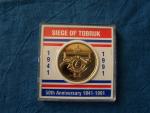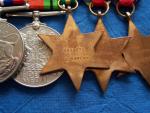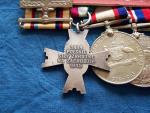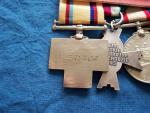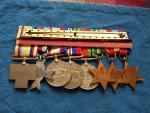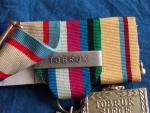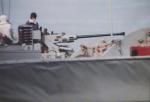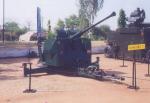-
Posts
1,411 -
Joined
-
Last visited
-
Days Won
1
Content Type
Profiles
Forums
Blogs
Gallery
Events
Store
Everything posted by Tiger-pie
-

Tobruk Group
Tiger-pie replied to Tiger-pie's topic in Great Britain: Orders, Gallantry, Campaign Medals
-

Tobruk Group
Tiger-pie replied to Tiger-pie's topic in Great Britain: Orders, Gallantry, Campaign Medals
-

Tobruk Group
Tiger-pie replied to Tiger-pie's topic in Great Britain: Orders, Gallantry, Campaign Medals
-

Tobruk Group
Tiger-pie replied to Tiger-pie's topic in Great Britain: Orders, Gallantry, Campaign Medals
-

Tobruk Group
Tiger-pie replied to Tiger-pie's topic in Great Britain: Orders, Gallantry, Campaign Medals
II Corp, made up of the 6th, 7th and 9th Divisions fought in North Africa and were recalled to Australia to fight in the Pacific in 1942. The only ones who didn't get the Africa Star and Pacific Star combination were the ones they left behind in the deserts of Egypt and Libya, and the 'new chums" that joined the battalions when these Divisions refitted back in Australia. Regards; Johnsy -

Tobruk Group
Tiger-pie replied to Tiger-pie's topic in Great Britain: Orders, Gallantry, Campaign Medals
-

Tobruk Group
Tiger-pie replied to Tiger-pie's topic in Great Britain: Orders, Gallantry, Campaign Medals
Well they obviously have no bloody idea about Australian military history. The 7th Division, known as the "Silent Seventh" fought in practically every major battle the Australian army was involved in. Battle honours North Africa Giarabub Defence of Tobruk The Salient 1941 South-West Pacific 1942-1945 Buna-Gona Sanananda Road Cape Endaiadere-Sinemi Creek Sanananda-Cape Killerton Milne Bay Liberation of Australian New Guinea Shaggy Ridge Finisterres Borneo 1945 Balikpapan -

Tobruk Group
Tiger-pie replied to Tiger-pie's topic in Great Britain: Orders, Gallantry, Campaign Medals
-

Tobruk Group
Tiger-pie replied to Tiger-pie's topic in Great Britain: Orders, Gallantry, Campaign Medals
-

Tobruk Group
Tiger-pie replied to Tiger-pie's topic in Great Britain: Orders, Gallantry, Campaign Medals
-

Tobruk Group
Tiger-pie replied to Tiger-pie's topic in Great Britain: Orders, Gallantry, Campaign Medals
-

Tobruk Group
Tiger-pie replied to Tiger-pie's topic in Great Britain: Orders, Gallantry, Campaign Medals
-

Tobruk Group
Tiger-pie replied to Tiger-pie's topic in Great Britain: Orders, Gallantry, Campaign Medals
-

Tobruk Group
Tiger-pie replied to Tiger-pie's topic in Great Britain: Orders, Gallantry, Campaign Medals
-
Service Record Name TAYLOR, VICTOR JAMES Service Australian Army Service Number NX16370 Date of Birth 12 Feb 1920 Place of Birth SYDNEY, NSW Date of Enlistment 22 May 1940 Locality on Enlistment REDFERN, NSW Place of Enlistment PADDINGTON, NSW Next of Kin TAYLOR, GEORGE Date of Discharge 3 Dec 1945 Rank Corporal Posting at Discharge 2/4 Field Company WW2 Honours and Gallantry None for display Prisoner of War No
-

antique canons and artillerie in spain
Tiger-pie replied to HeikoGrusdat's topic in Firearms & Ordnance
Their gunlayer needs to be sacked... -

the navy of Marocco....
Tiger-pie replied to HeikoGrusdat's topic in Armour, Vehicles, Ships & Aircraft
It is unlikely that any navy will engage in a ship to ship battle of that type again, it is all fire and forget these days. A strong navy is still a requirement as so many operations require it for maritime patrols, blockades (sanctions), NGS (Naval Gunnery Support), use of carriers for air cover, onboard medical facilities, POL, food / ammo / water, troop deployment and so on. For a country the size of Morocco, the above is probably not a requirement. Much like the other navies around the world, patrol boats are used for border protection. Having served on PBs "barking up and down the fence" I know it is a tough, dangerous job with little or no recognition from the Head Shed, as they tend to forget about their "Minor War Vessels". It made me laugh when I went back to big ships, I asked the Chief in charge of boardings if he required any additional personnel to help out. He asked me what would I know about boardings. I asked him how many he had done, to which he replied none. I said , "Well Chief, I have done about 700". Regards; Johnsy -
Wish I had got here a bit earlier, as soon as I saw the FX (foc'sle) I could see it. Even as a techo I have helped "drop the pick" a few times. Regards; Johnsy
-

the navy of Marocco....
Tiger-pie replied to HeikoGrusdat's topic in Armour, Vehicles, Ships & Aircraft
Thanks for the shots. They are some ugly lookin' barges... Regards; Johnsy -

Australian cloth patches
Tiger-pie replied to Bob Lyons's topic in Great Britain: Militaria: Badges, Uniforms & Equipment
Very little really other than an extra "A". Some of the brevet badges for specialist i.e Engineer, have different letters to British type. Regards; Johnsy -
-
-
G'da Andy I am fairly confident that it is the 40/70 Flash Guard you, I can confirm that is not for the 40/60. With the 40/60 FG the base of the collar was designed so that a huge spanner could fit onto it to loosen the FG so you could remove it. With the FG you have there it has interrupted thread, the 40/60 was fully threaded, which made it a nigtmare to get off, especially if there was any corrosion. Your example has a locking device at the base, again this was not fitted to the 40/60 as the barrels would not be able to accept this. The 40/40 barrels were pre-drilled for three Allen key grub screws to hold the FG in place, again a problem if there was any corrosion, and a pain in the 'arriss when you tried to line them up. Considering how long this weapon has been around it is almost impossible to find decent images. The shots I have supplied below should illustrate the difference, the naval mounts being the 40/60, the other an 40/70 AA mount. Regards; Johnsy
-
G'da Hugh; Yes it is a great gun, and it very much an end of an era for our navy now that it has gone. Countless weapons technicians have been trained on this gun as it is easy to strip down and put back together and it has all the basic principals that can be applied to larger calibre weapons. Bofors still produce the ordnance, but it is a self loader within a turret. I think we should have bought it for the new Armidale patrol boats. In the picture below the 40mm is in the foreground. They have developed advanced munitions for the 40mm and 57mm: Programmable for optimized effect and tactical flexibility. Air-burst capability. Immune to ECM. Powerful pre-fragmented shell. Maintained fuze triggering distance even at long firing ranges. Qualified as Insensitive Munitions with PBX explosives and LOVA-propellant. Each 3P fuze is automatically and individually programmed by a Proximity Fuze Programmer (PFP) which continuously receives data from the Fire Control Computer. Immediately before firing the fuze is programmed to the selected mode. The following modes can be selected: Gated proximity mode (air defence). Gated proximity mode with impact priority (air defence, large targets). Time mode (small fast, manoeuvring surface targets and concealed on-shore targets). Impact mode (surface targets). Armour piercing mode (armoured surface targets). Proximity mode (default mode). Regards; Johnsy






